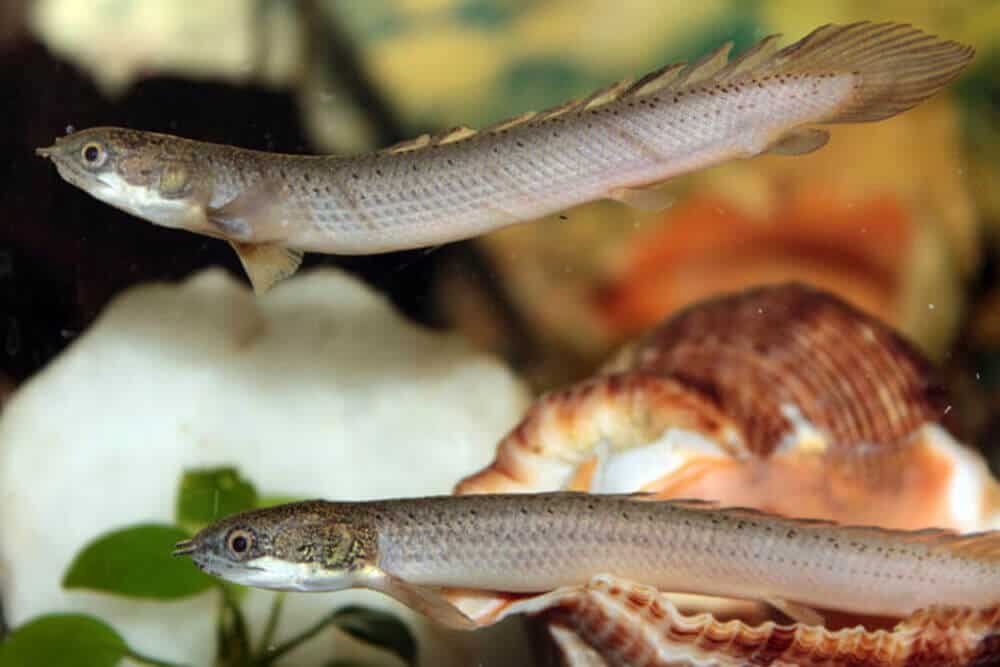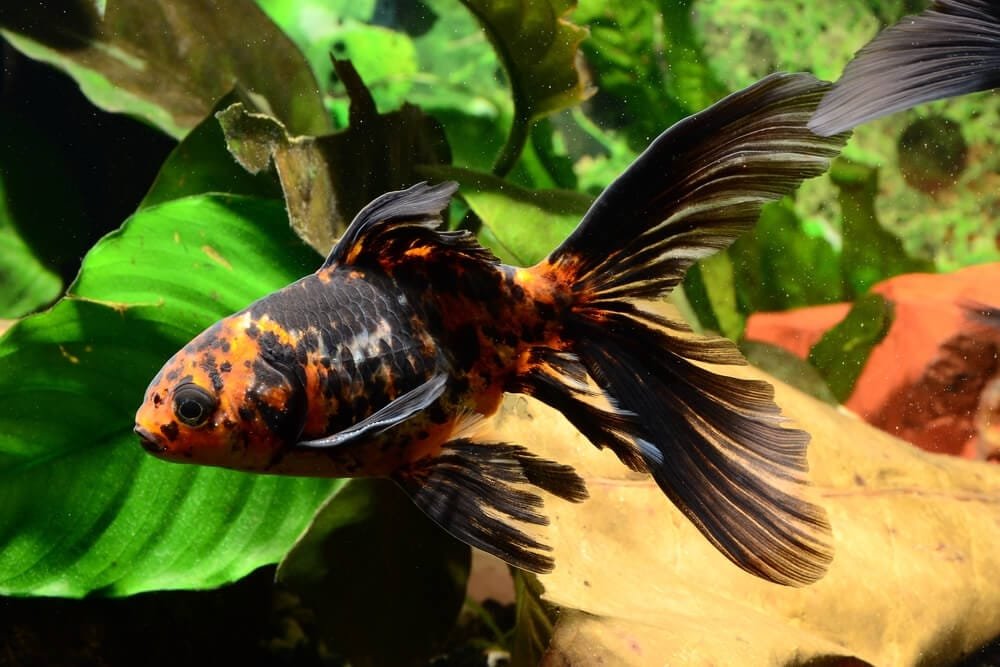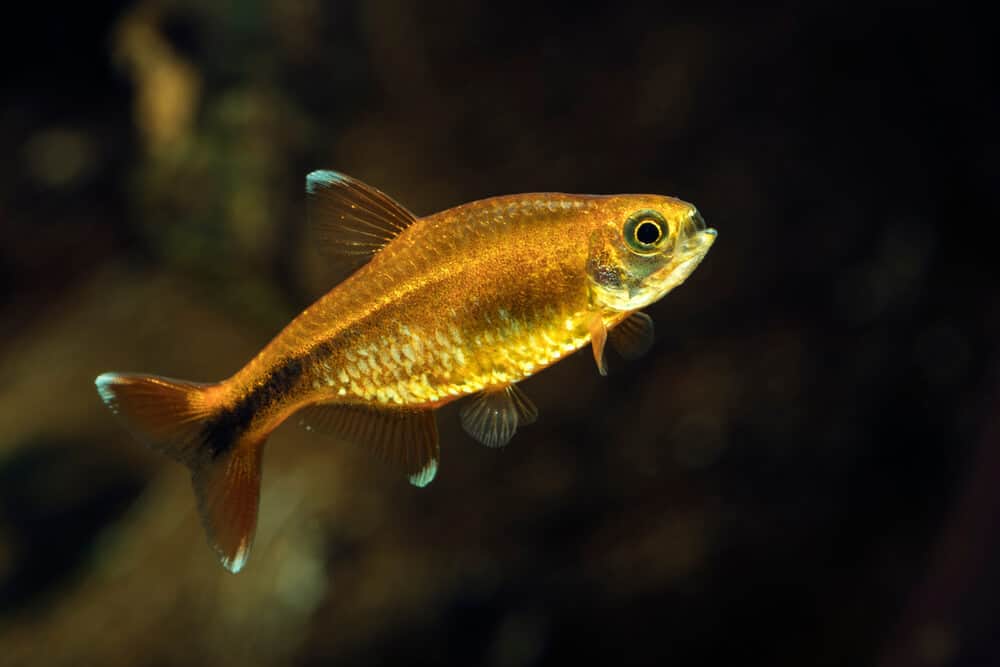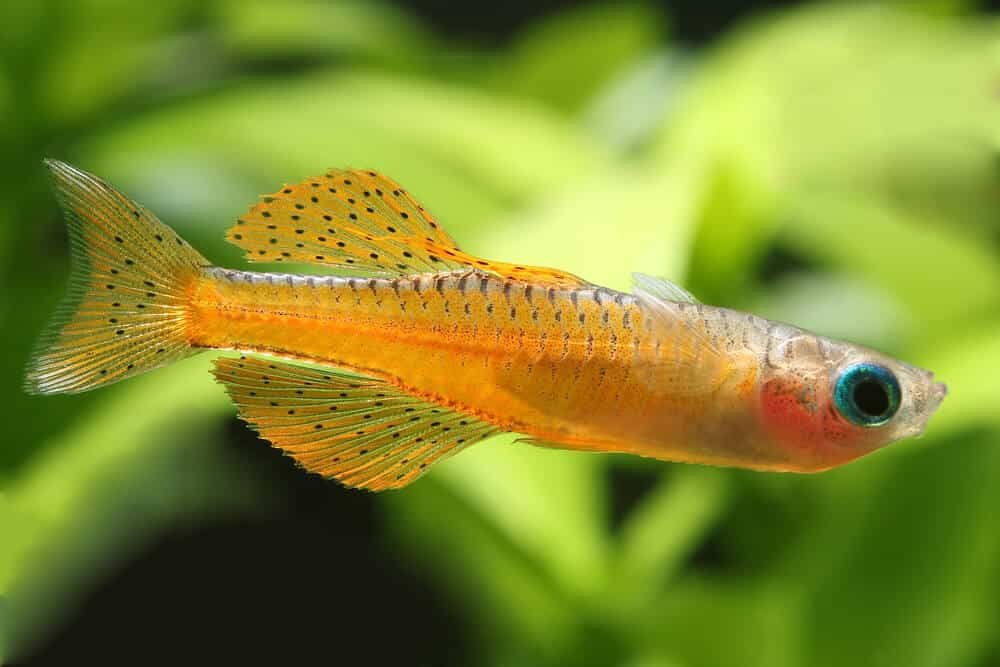
If you think that finding Dinosaur Bichir tank mates is challenging, you are right. This is because the fish predate on some fish and some fish predate on them. So you want as much as possible to have an environment conducive to this fish species.
Dinosaur Bichirs aren’t too aggressive but have a large appetite and tend to grow large in size. In choosing tank mates for them, you have to prioritize fish that will add variety but won’t be eaten by the Bichirs.
This article suggests African Butterfly Fish, Flowerhorn Cichlid, Hoplo Catfish, Pink Convict Cichlid, Oscar Fish, Silver Dollar Fish, Blue Acara, Leopard Ctenophora, Black Ghost Knife Fish, and Elephant Nose Fish as the best Dinosaur Bichir tank mates.
Dinosaur Bichir Overview
This particular fish comes bearing a lot of other names. It is also known as Senegal Bichir, Reed fish, Dinosaur eel, or Swamp Dragon.
This fish can be found in the wild, floodplains, rivers, lakes, and swampy areas. It is a freshwater fish, so you can’t find one in the ocean.
This fish is native to many African countries like Nigeria, Senegal, and Kenya. It has also been found in other countries across the Nile River to West Africa.
This fish’s unique and specific features make it easy to recognize. It has a thin, long body making it look like an eel.
Also, the teeth are well pronounced, and the nostrils protrude. It got the name Swamp Dragon because it resembles a dragon.
This fish is known to lie low at the bottom of the tank waiting for prey to devour. They are carnivorous. This is why knowing the best Dinosaur Bichir tank mates is crucial because you don’t want them eating all the other fish in the tank.
Even though they are not as wide as many species, this is one very long fish. A fully grown Dinosaur Bichir can be as long as 20 inches (50 cm).
This fish species can live up to 15 years as long as you take good care of them and give them suitable tank mates in building a community.
Top 10 Dinosaur Bichir Tank Mates
1. African Butterfly Fish
Size: 5 inches
Minimum Tank Size: 40 gallons
Temperament: Semi-aggressive
Diet: Carnivorous
Care Level: Intermediate

This freshwater fish is also known as the Freshwater Butterfly Fish. This species is different from the saltwater butterfly fish, which is just a look-alike. So don’t make the mistake of opting for the latter.
You can find this fish in many large water bodies in West Africa. They are found in water with very little to no current. So ensure you place them in an aquarium with similar water characteristics to help them thrive.
One feature that is fascinating about this fish is its ability to glide. It can jump through the air because of its fins that resemble wings. This feature becomes handy when they want to escape their predators.
They can be a handful to care for, making the fish unsuitable for beginners. They can be picky with food and reject foods like pellets and flakes.
Their favorite happens to be crickets. You can as well opt for feeder fish and some other insects.
They are relatives of Arowana with unique habits, such as acting like fallen debris while waiting for prey to come near.
Keep this species with smaller Bichirs as the larger fish may try to feed even on fully grown African Butterfly Fish.
2. Flowerhorn Cichlid
Size: 10-16 inches
Minimum Tank Size: 70 gallons
Temperament: Aggressive
Diet: Omnivorous
Care Level: Moderate

This fish species does not naturally exist in a typical habitat because they were bred in captivity. Breeding started in Malaysia, Taiwan, and Thailand until it spread to other Asian countries, Central America, Europe, and the US.
If you have found them in the wild, know that they are not supposed to be there. They may have only been released by people and have rapidly become an invasive fish type in many countries.
This fish is a beauty to behold which is why it often gets the spotlight in aquariums. They come in different patterns and colors, and many enthusiasts adore their bubbly foreheads.
They have very distinct personalities and tend to rule the aquarium. The aggressive tendency for this fish would make you think it’s not a good pick for Dinosaur Bichir, but that’s not the case.
One downside is that it’s very space-demanding. You need at least 70 gallons to keep this fish.
They enjoy staying on all levels in the doors. You will see them move freely in the tank.
Flowerhorns feed on a high-protein diet, but about 30% of their food should be plant sources. Their food ranges from insects to shrimps, algae, wafers, and blanched veggies.
They can live up to 12 years, but their lifespan still depends on how you care for them.
3. Hoplo Catfish
Size: 6-8 inches
Minimum Tank Size: 30 gallons
Temperament: Peaceful
Diet: Omnivorous
Care Level: Beginner

The Hoplo catfish is a favorite for many because this fish is peaceful and easy to tend to. It’s also adaptable, energetic, and gets along with many fish species.
They may be small but often full of energy and curiosity. You will often see them tagging along or looking directly into the other fish in the tank.
Their curiosity often gets them into trouble with the other fish, but other than that, they are easy to take care of and thrive with the other fish species.
Despite being small, they don’t get easily hurt or get eaten by other fish. They protect themselves using their pointy spines.
They handle themselves well, so it will not be a big deal even if you put them in the same tank as the bigger species like the Dinosaur Bichir.
Also, Hoplo catfish move pretty fast but tend to stay at the bottom of the tank. They also enjoy eating at the bottom of the tank. The good thing is they are nocturnal, so feeding wouldn’t be hard for you.
You will need a large space to care for Hoplo with Senegal Bichir. This way, there won’t be any territorial fights.
They eat a wide range of food as well. They enjoy foods like worms, insects, small crustaceans, pellets, flakes, algae, and vegetables.
A tip is to feed different species in different parts of the tanks. If not, you will have to deal with Hoplo catfish gulping down all the food in no time as they are fast swimmers.
4. Pink Convict Cichlid
Size: 5-6 inches
Minimum Tank Size: 30 gallons
Temperament: Aggressive
Diet: Omnivorous
Care Level: Easy

This is another cichlid that would do just well with Dinosaur Bichir. It is one of the most sought-after in the Cichlidae family, even though it’s smaller than others.
It has a unique look you can’t get your eyes off. The body is light pink, which is a rare find. The species will make your tank colorful and a pretty sight.
However, don’t be fooled by the looks of this fish. They are not the nicest in the tank and can be feisty and aggressive. This is their way of keeping themselves safe from bullies.
The fish is known to be territorial and competitive, so avoid pairing it with smaller fish species that are vulnerable. It is better to pair it with larger fish or a small aggressive fish.
You can put it in the same tank as Bichirs, but don’t expect them to get along all the time. The Pink Convict Cichlid may likely bully the bigger species.
When adding them to the tank along with Bichirs, it is best to add many hiding spots where they can go in case of trouble. They will likely not have any encounters during the day since Bichirs are not as active as the Pink Convict Cichlid when the sun is out.
The species enjoy rocky substrates, so you will often find them in caves and rocky areas of the tank, trying to hide. The good thing about them is that they are not picky eaters.
They will feed on just about anything – meat, veggies, dry food, live food, insects, fish flakes, or algae.
5. Oscar Fish
Size: 10-12 inches
Minimum Tank Size: 55 gallons
Temperament: Semi-aggressive
Diet: Omnivorous, opportunistic feeders
Care Level: Moderate

This freshwater fish is commended for its appearance and behavior. They are highly popular now with aquarium hobbyists that you can find them anywhere in the world, but the species originated from the tropical regions of South America.
The popularity of this fish is mainly due to being attractive. Its body is black with bright orange patterns that make it look attractive.
There are many varieties of this fish, and each one is uniquely stunning.
The shape is another highlight because they have a nicely rounded head with fins.
They are just about the same size as the Senegal Bichir, so despite being generally peaceful, they won’t be easily eaten by the other species in the tank.
However, they can also cause trouble in the aquarium for being territorial. If it senses any predator, it starts to bite and bump.
But if the space seems peaceful, you can be sure it will not get aggressive. Oscars and Bichirs don’t interact as much and tend to stay in the middle portion of the tank.
Oscars mostly feed on pellets, fish flakes, live foods, and plants. They enjoy most of the foods that Bichirs enjoy.
The only thing that makes it difficult to care for Oscars is that they are diurnal. This means that they have no permanent feeding time.
6. Silver Dollar Fish
Size: 6 inches
Minimum Tank Size: 10-15 gallons
Temperature: Peaceful
Diet: Omnivorous
Care Level: Beginner

This unique freshwater fish is another popular species among aquarium hobbyists. They look interesting and appealing.
The best trait of this fish is that it is low-maintenance. Caring for this species is easy, and they make a great addition to community tanks even with the presence of Bichirs.
The Silver Dollar fish has a thin and tall build, making it easier for them to glide between stems. They can eat any plant that gets in their way, giving them the nickname the plant piranha.
So if you add them to the tank, be ready to refill the natural plants regularly since the species feed primarily on plants.
The species are timid and mellow when socializing with other fish types. But when they are around their own kind, they tend to be much more sociable and confident. So when keeping them, it is recommended to group them by a minimum of five.
While they prefer plants more than live food, you can still give occasional blood worms, shrimps, and daphnia. You can give them aquatic plants, certain fruits, green vegetables, and algae as their regular food.
7. Blue Acara
Size: 6-8 inches
Minimum Tank Size: 30 gallons
Temperament: Peaceful
Diet: Omnivorous
Care Level: Easy

Blue acara is a colorful fish from the cichlid family that lives in flowing streams, standing water, and other freshwater habitats. It is beautiful with a compact and stocky body.
The color is steel blue-gray with scales in the hues of bluish-green and green horizontal lines on the face. There’s a hint of orange at the tip of their flowing and long fins.
This has a mild temper, unlike the many other cichlid varieties. This makes them easy to blend with other fish in the tank, including the Dinosaur Bichir.
It isn’t too small, so you don’t have to worry about it being eaten. They will survive the tank and easily coexist with peaceful and semi-aggressive species.
Blue acaras tend to keep company with the same species, so you won’t have any problem with them disturbing the other fish types in the tank. They won’t usually cause trouble since they are not intimidating and don’t have solid territorial tendencies.
They enjoy just about all the spots in the tank. Sometimes, they are middle swimmers, and some other times they go a bit lower.
Also, there are times they enjoy hiding in crevices and caves. They also do a good job digging substrate.
The blue acaras feed more on protein. Aside from a high protein diet, you can also throw in some greens from time to time.
They also eat the same food as the Dinosaur Bichir food. But unlike Bichirs, which are nocturnal, Blue acaras are diurnal. You have to keep watch when they want to eat because it won’t be the same time every day.
8. Leopard Bush Fish (Leopard Ctenopoma)
Size: 6-8 inches
Minimum Tank Size: 50 gallons
Temperament: Peaceful
Diet: Omnivorous
Care Level: Moderate

This fish has a tall body, and the sides are flattened. It has large eyes with an elongated mouth.
It is yellowy-brown with dark spots all over the fins and body. Many say it is similar to a leopard spot. This is why it is also known as the leopard bush fish.
It is one calm and quiet fish, so coexisting with other fish isn’t a problem. It does best with fish similar in size, but they will also get along well with Bichirs.
They tend to eat the smaller fish, so it is best not to put them in a tank with smaller fish species. It stays a lot in the bottom of the tank and sometimes in the middle.
They love hanging out in shelters, so it is best to place half coconut shelves, flower pots, caves, and crevices in the tank where they can hide.
They mostly feed on live food, such as blood worms, shrimps, and live fish, but you can also give them frozen food or plants.
9. Black Ghost Knife Fish
Size: 20 inches
Minimum Tank Size: 80 gallons
Temperament: Semi-aggressive
Diet: Carnivorous
Care Level: Moderate

The fish is similar to Bichirs when it comes to appearance because of the color. It has no scales, caudal, and dorsal fins.
It has a rod-shaped tail that is thin and smooth; hence, knife was added to its name.
They may be larger than Bichirs but get along well with medium-sized fish. Despite the size, the fish is reserved and shy.
They will thrive well along with Bichirs since they are generally peaceful. They can also easily get along with the other fish in the tank.
The only time that you may notice a change in its attitude is when it is paired with other Ghost Knife fish species. They become competitive and aggressive when they are with their own kind.
To be safe, keep only one Black Ghost Knife fish in the tank along with other fish species. This will ensure peacefulness in the aquarium, and you will also save space in the tank.
They are nocturnal, similar to Bichirs, and both species are bottom dwellers. They also both enjoy seeking hiding spaces.
So when you keep the Knife fish and Bichir in the tank, ensure ample space with many hiding spots. They also eat similar food as Bichirs, so you can feed them with small fish, insects, worms, shrimp, and larvae.
10. Elephant Nose Fish
Minimum Tank Size: 50 gallons
Size: 7-10 inches
Temperament: Semi-aggressive
Diet: Carnivorous
Care Level: Moderate

The fish got its name from the funny shape of its head. It has sloped foreheads and long noses. Also, they have small bodies with very long tails.
Many hobbyists say they look cute and goofy. But don’t be fooled by their looks because they tend to be aggressive when kept in a tank with smaller fish.
However, they tend to behave and peacefully co-exist with larger tank mates. This makes them a perfect companion for Bichirs.
Also, they have strong personalities, so it would be hard for other fish species to bully them. Just like Bichirs, they are also bottom-dwellers.
Elephant-nose fish is most active during the day when the lights are dim or early hours of the evening. So you can be sure they won’t be disturbing the Bichir late at night.
They enjoy feeding on insects and their larvae, worms, and crustaceans.
Frequently Asked Questions
How Big Of A Tank Does A Dinosaur Bichir Need?
The minimum tank size for a Dinosaur Bichir is 50 gallons. They need ample space to swim and move around. It is also necessary to keep the water clean.
Can Axolotl Live With Bichir?
No, you can’t put the two in one tank. First, Axolotl thrives well in cool water while Bichirs survive in warm water. Also, the Bichir is most likely to attack your Axolotl. So it’s best to keep them at different tanks if you want to maintain peacefulness at both tanks.
Can A Bichir Drown?
The Bichirs use their gills and lungs for breathing, but the gills are not strong enough to absorb oxygen. So, they rise to the water’s surface from time to time to use their lungs for breathing.
Their air passage may dry when they fail to make it to the surface to breathe using their lungs when it’s time.
Is A Bichir An Eel?
This fish species is a primitive freshwater fish that looks like an eel. But they are two different species often confused to be the same.
What Substrate Is Best For Bichir?
The most recommended substrate for Bichir is the sandy substrate. This is because they are very comfortable and are used to it.
It is also considered safe for them because they are bottom dwellers.
Conclusion
Finding the best Dinosaur Bichir tank mates can be challenging, but you have a lot to choose from. Ensure that you keep them away from smaller fish species, which they might feed on.
Among the most suitable tank mates for the species include African Butterfly Fish, Flowerhorn Cichlid, Hoplo Catfish, Pink Convict Cichlid, Oscar Fish, Silver Dollar Fish, Blue Acara, Leopard Ctenophora, Black Ghost Knife Fish, and Elephant Nose Fish.
However, it’s still up to you which species to add to a fish tank along with the Bichir. Just make sure you study their characteristics and ensure they will survive the traits and behavior of Bichirs.





